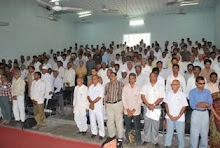Chandigarh Tribune: Chandigarh: Tuesday,
October 25, 2016.
A refurbished
RTI system, while balancing competing interests and pre-empting misuse, should
be able to accommodate change in keeping with the credo of the times. The
multi-tiered RTI system needs a criteria-based legal filter to sift out
vexatious applications.
THE nature
and scope of RTI must be rationalised to meet the evolving information demand.
The RTI regime should adapt to national security, public safety and financial
probity concerns such as the Uri-Pathankot infiltrations, Kolkata flyover
collapse, Bhubaneswar hospital fire safety lapses, the Kingfisher scam or BCCI
cleanup. Accordingly, the institutional gaps ought to be addressed.
Questions abound. Is it logical to keep the
military under RTI protocol, while exempting the para-military like BSF, CRPF,
CISF, ITBP from information disclosure, which is presently the case? RTI's
vulnerability to information-fishing and the porosity of forward areas to
cross-border terrorism cannot be ignored. How to explain that the exempt
organisations include Sashastra Seema Bal and Assam Rifles but not the Army,
Navy and Air Force?
Further, has RTI's "public
authority" raison d'etre become out-of-sync with the reality that private
entities are increasingly controlling public services with
safety-health-environment implications? Does RTI's differentiated treatment of
the public and private sectors affect fair competition? How best to promote
voluntary disclosure and automaticity through compatible technologies. Why was
the CBI, an investigating agency with RTI obligations in the original statute,
put in the exempt-list earmarked essentially for intelligence and security
agencies?
The manoeuvres to keep the CBI Director's
visitor-logbook under wraps rekindled doubts about the intent behind the
afterthought inclusion of CBI in the exempt-list, considering that there were
safeguards already available to deny information not amenable to disclosure. In
this case, the record of visitors was believed to be indicative of the
influences impacting the coal block and 2G investigations. The
information-seeking sentiment gets sparked when facts are fenced-in by
"public authority" or "exempt-list" definitional
boundaries. Instances arousing public interest would include the allegation of
maltreatment by CBI in the BK Bansal suicide case.
An openness to sharing information is vital
for human welfare. The Bhopal Gas Tragedy signals that chemical safety and
prevention of industrial disaster is a paramount goal not to be compromised.
Hence, a privately owned entity handling toxic material should not be shielded
behind “public authority” legalese. Public-private partnerships have brought
both spheres closer, though it must be recognised upfront that the RTI Act
itself envisages disclosure of information related to a private entity if it is
legally available with a public authority. Rules should be framed to allow this
window to be deployed usefully for regulatory systems such as in pollution
control, electricity distribution, telecom services or food standards, which
are gearing up for greater accountability.
Rationalisation induces fairness. RTI has been
moulded to access information controlled by public authorities, but this should
not lead to the benchmarking of transparency where the passenger safety
performance of government-supported Air India is treated at a level of scrutiny
different from other commercially competing privately owned airlines. A level
playing field implies that RTI transparency for passenger safety in Air India
will be the same as its competitors. The RTI standing of information from IOC,
ONGC or BHEL pertinent to industrial safety should not allow private sector
competitors to discount responsibility.
RTI is a tool for good governance. It can
marshal information for assessing performance and public service delivery. So, if a new bridge across a river is the
subject of RTI, apart from process-related tendering procedures, contract-terms
or delays, the system should be able to inform whether the functional promise
of the end-product is being met. Easy retrieval of facts about actual
achievement will come from an RTI-Digital India blend. Bridging of the digital
divide visualises websites in local language and creation of mobile-friendly
systems for knowledge-sharing. The National Data Sharing and Accessibility
Policy provides for access to government owned data, the ultimate aim being
enhancement of citizen welfare through hassle-free information.
Periodic data-analytics of applications and
responses will enable public authorities to anticipate trends and build
capacities for digitisation, categorisation, retrieval and reconciliation of
online and offline data. Records get stored but are often difficult to
retrieve. Missing files are common. Wider internet use expands information
supply and promotes equitable access, without the need to file applications.
Actually, much of the ongoing transparency initiatives are outside the RTI
domain.
A wealth of data, whether on crime or weather,
mandi-trade or sectoral datasets, is accessible on government's
open-data-portal. MGNREGA and land acquisition exemplify availability of
information at various levels of usage, but it is doubtful if citizens are
utilising this window adequately to hold the public authority accountable.
Sub-optimal functioning has to be flagged. Former Chief Justice of India SH
Kapadia was reported to have said: “…a very good law like RTI was being misused
to ask irrelevant and intrusive questions…” A fall-out is that information flow
has become needlessly voluminous making the application-driven system
operationally unsustainable. Often, there is indiscriminate use of RTI by
government employees when normal grievance redressal mechanisms do not work.
RTI is time-bound hence preferred over departmental channels for arrear
payments, promotions, postings or penalty proceedings.
An easy-to-use cost-effective lifeline for
many, the multi-tiered RTI system also needs a criteria-based legal filter to sift
out vexatious applications. There's the instance of some thousands of RTI
applications submitted to the IAF by a retired officer taking the position of a
whistleblower. The cases, more or less similar, accounted for a significant
part of the CIC's total pendency. The IAF attended to some cases despite the
feeling that the gravitas of their defender-of-the-sky role was affected by
unreasonably repetitive paperwork. Mounting pendency, inconsistent decisions,
weak compliance, indifference to voluntary disclosure, all require attention.
The provisions releasing the information-holder from disclosure obligations
need recalibration considering, for instance, that errant banking has dented
the fiduciary-relationship argument used to stave off information about bad
debts and non-performing assets. Simultaneously, parallel regimes like consumer
protection, fair competition, electoral regulation are maturing. A CIC
decision, presently dormant, directed information disclosure from national
political parties as public authorities. A beginning can be made with electoral
funding accountability under RTI that includes political parties with
legislators even if the parties fall short of meeting the "national
political party" criteria. An appraisal of past implementation will help
identify the legal and institutional gaps to be plugged. The RTI law and
working rules also ought to be rationalised with an eye on the future. This is
in view of increasing private control of public services, the information
demand triggered by rising safety-health-environment concerns, conflict with
privacy laws, national security and other questions raised above. Legislative
intent will guide, but whether this would resonate with wider transparency
expectations, say, having an RTI protocol for political parties, is a question.
(The writer is a former Chief Information
Commissioner, & Secretary to GoI in Ministry of Environment & Forests.)














































































